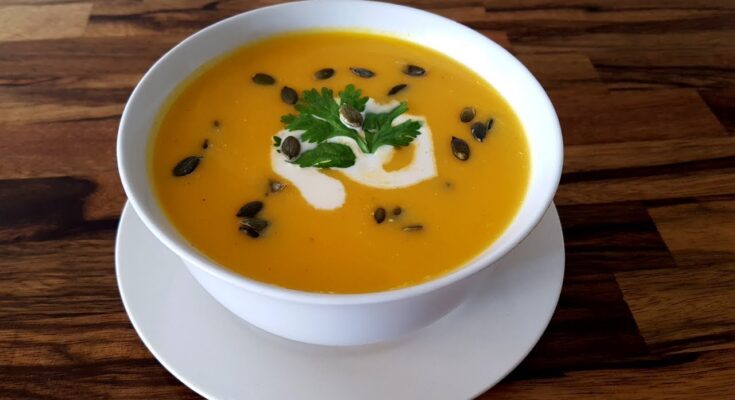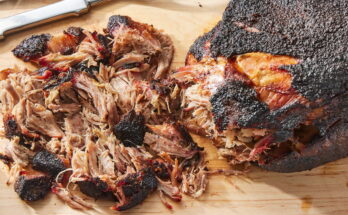Pumpkin Soup Recipe: Pumpkin soup is a cozy, heartwarming dish perfect for chilly evenings or anytime you crave comfort food.
Packed with flavor, it’s not just delicious but also incredibly nutritious, loaded with vitamins like A and C, along with essential minerals.
Whether you’re a beginner in the kitchen or a seasoned cook, this step-by-step guide will help you whip up a creamy, flavorful pumpkin soup that will leave everyone asking for seconds.
Ingredients Needed for Pumpkin Soup
To create the perfect pumpkin soup, you’ll need:
- Pumpkin (2-3 cups, peeled and diced)
- Onion (1 medium, chopped)
- Garlic cloves (2-3, minced)
- Vegetable stock or chicken stock (3-4 cups)
- Cream or coconut milk (½ cup, optional for creaminess)
- Olive oil or butter (2 tablespoons)
- Salt and pepper (to taste)
- Optional spices: Nutmeg, paprika, or curry powder for extra flavor
Tips for selecting the best pumpkin: Choose firm pumpkins with smooth skin. Smaller varieties like sugar pumpkins or pie pumpkins are sweeter and perfect for soups.
Tools Required for Making Pumpkin Soup
- A large pot or Dutch oven
- Knife and cutting board
- Blender or immersion blender
- Measuring cups and spoons
- Optional: Ladle for serving and airtight containers for storing
How to Make Pumpkin Soup
Step 1: Preparing the Pumpkin
Choosing and cleaning the pumpkin:
- Start with a medium-sized pumpkin. Wash it thoroughly to remove dirt and debris.
- Cut the pumpkin in half and scoop out the seeds. Save the seeds for roasting if you like!
Peeling and cutting:
- Use a sharp knife or vegetable peeler to remove the skin.
- Dice the pumpkin into small cubes for faster and even cooking.
Step 2: Sautéing the Aromatics
Aromatics like onion and garlic lay the foundation of flavor for your soup.
- Heat olive oil or butter in a large pot over medium heat.
- Add chopped onion and sauté until translucent, about 5 minutes.
- Stir in minced garlic and cook for another minute until fragrant.
- For an extra layer of flavor, sprinkle in spices like nutmeg or paprika during this stage.
Step 3: Cooking the Pumpkin
- Add the diced pumpkin to the pot with the sautéed aromatics. Stir to coat the pumpkin with the aromatic mixture.
- Pour in the vegetable or chicken stock, ensuring the pumpkin is fully submerged.
- Bring the mixture to a boil, then reduce the heat to a simmer. Cover and cook for 20-25 minutes until the pumpkin is fork-tender.
Step 4: Blending the Soup
- Remove the pot from the heat and let it cool slightly.
- Use an immersion blender directly in the pot to blend the soup until smooth. If using a countertop blender, blend in batches to avoid spills.
- If the soup is too thick, add a bit more stock or water to achieve your desired consistency.
Step 5: Adding Creaminess and Seasoning
- Stir in cream or coconut milk to add a rich, velvety texture. For a dairy-free option, almond or cashew milk works well.
- Season with salt and pepper, tasting as you go. Adjust spices like nutmeg or curry powder to enhance the flavor.
Serving Suggestions
Pumpkin soup is versatile and can be elevated with the right accompaniments and garnishes.
Creative garnish ideas:
- Swirl of cream or coconut milk for a visually appealing presentation.
- Fresh herbs like parsley, cilantro, or chives for a pop of color and flavor.
- Toasted pumpkin seeds for crunch and added texture.
- A sprinkle of paprika, nutmeg, or a drizzle of chili oil for an extra kick.
Pairing suggestions:
- Serve with crusty bread or garlic bread for dipping.
- A light side salad complements the rich creaminess of the soup.
- Add a handful of crackers for a quick, satisfying meal.
Variations of Pumpkin Soup
One of the best things about pumpkin soup is its adaptability to various tastes and dietary needs.
Spiced pumpkin soup with curry:
- Add a tablespoon of curry powder during the sautéing stage for a bold, aromatic flavor.
- Include coconut milk and garnish with fresh cilantro for a Thai-inspired twist.
Vegan and gluten-free options:
- Replace cream with coconut milk or almond milk.
- Use gluten-free vegetable stock to cater to gluten-sensitive diets.
Roasted pumpkin soup:
- Roast the pumpkin cubes with olive oil, salt, and pepper at 400°F (200°C) for 30 minutes before adding to the soup. Roasting enhances the natural sweetness of the pumpkin.
Tips for Storing and Reheating Pumpkin Soup
Storing:
- Allow the soup to cool completely before transferring it to airtight containers.
- Refrigerate for up to 4 days or freeze for up to 3 months.
Reheating:
- Reheat on the stove over low heat, stirring occasionally to prevent sticking.
- If the soup thickens in the fridge, add a splash of stock or water to thin it to the desired consistency.
Health Benefits of Pumpkin Soup
Pumpkin soup isn’t just delicious; it’s packed with health benefits:
- Rich in vitamins: Pumpkin is a powerhouse of vitamin A, supporting eye health and immunity.
- High in antioxidants: Helps combat free radicals and reduces inflammation.
- Digestive benefits: The high fiber content aids digestion and promotes gut health.
- Low in calories: A great option for those looking for a nutrient-dense, low-calorie meal.
Common Mistakes to Avoid When Making Pumpkin Soup
Even a simple recipe like pumpkin soup can go awry if certain pitfalls are not avoided:
- Overcooking or undercooking the pumpkin: Ensure the pumpkin is cooked until fork-tender for smooth blending.
- Using too much liquid: Start with less stock; you can always add more to adjust the consistency.
- Skipping the seasoning: Proper seasoning is crucial to bring out the soup’s natural flavors. Taste as you go!
- Blending carelessly: Always let the soup cool slightly before blending to avoid accidents.
FAQs about Pumpkin Soup Recipe
1. What type of pumpkin is best for making pumpkin soup?
The best type of pumpkin for soup is the Sugar Pie pumpkin, known for its sweet flavor and smooth texture. However, you can also use Butternut squash as a great alternative.
2. Can I make pumpkin soup without cream?
Absolutely! For a lighter version of pumpkin soup, you can substitute cream with coconut milk or simply use vegetable or chicken broth to enhance the natural creaminess of pureed pumpkin.
3. How can I thicken pumpkin soup?
To thicken pumpkin soup, consider adding a potato or two during cooking, which you can puree along with the pumpkin. Alternatively, a small amount of cornstarch or flour mixed with water can be added to achieve the desired consistency.
4. What spices go well with pumpkin soup?
Classic spices include cinnamon, nutmeg, and ginger, which complement the sweetness of the pumpkin. For a savory twist, try sage, thyme, or even a pinch of cayenne pepper for heat.
5. Is pumpkin soup suitable for freezing?
Yes, pumpkin soup freezes very well. Cool it completely before storing it in freezer-safe containers. It can be kept frozen for up to 3 months. Thaw in the refrigerator overnight and reheat on the stove or in a microwave.
6. What can I serve with pumpkin soup?
Pumpkin soup pairs beautifully with crusty bread or croutons. For a more filling meal, serve it alongside a green salad or a sandwich. Garnishing with roasted pumpkin seeds or a dollop of sour cream can also enhance the dish.
7. Can I use canned pumpkin instead of fresh?
Yes, canned pumpkin is a convenient and time-saving alternative to fresh pumpkin. Make sure to use pure pumpkin puree rather than pumpkin pie filling, which contains added sugars and spices.
Conclusion
Making pumpkin soup is a delightful and rewarding experience that combines simplicity with incredible flavor. Whether you stick to the classic recipe or experiment with variations, you’re guaranteed a comforting dish that’s perfect for any occasion. So grab your apron, embrace the process, and enjoy the satisfying warmth of homemade pumpkin soup.



